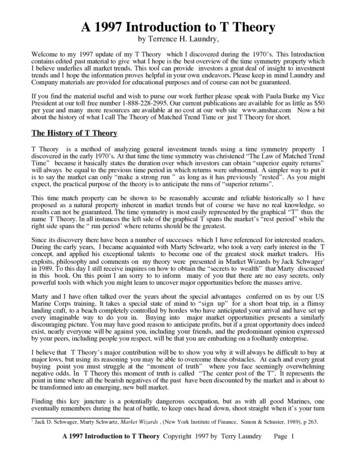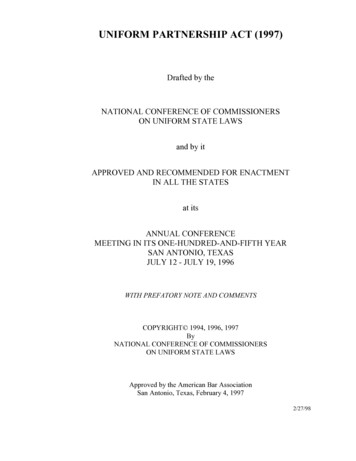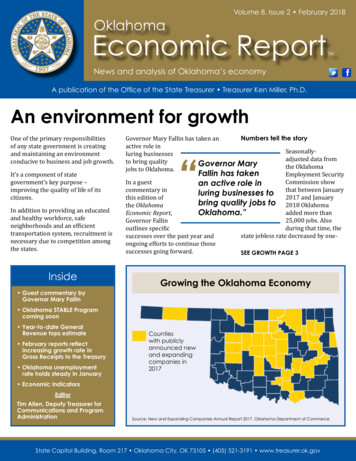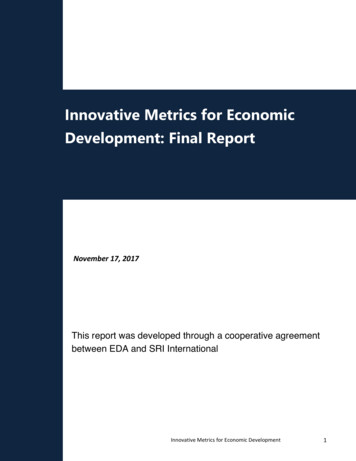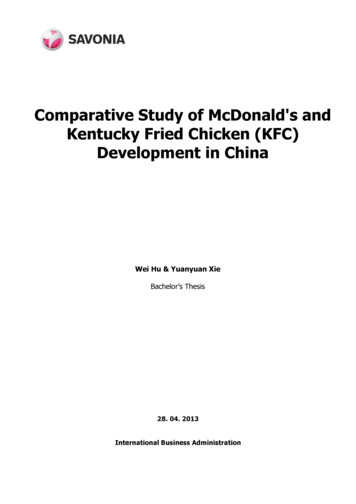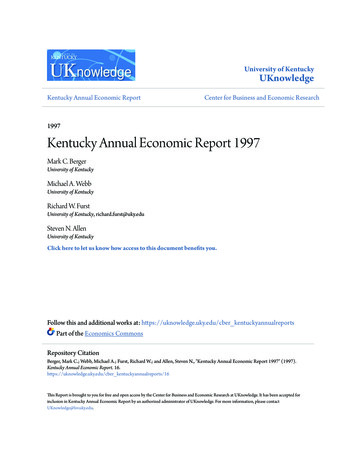
Transcription
University of KentuckyUKnowledgeKentucky Annual Economic ReportCenter for Business and Economic Research1997Kentucky Annual Economic Report 1997Mark C. BergerUniversity of KentuckyMichael A. WebbUniversity of KentuckyRichard W. FurstUniversity of Kentucky, richard.furst@uky.eduSteven N. AllenUniversity of KentuckyClick here to let us know how access to this document benefits you.Follow this and additional works at: https://uknowledge.uky.edu/cber kentuckyannualreportsPart of the Economics CommonsRepository CitationBerger, Mark C.; Webb, Michael A.; Furst, Richard W.; and Allen, Steven N., "Kentucky Annual Economic Report 1997" (1997).Kentucky Annual Economic Report. 16.https://uknowledge.uky.edu/cber kentuckyannualreports/16This Report is brought to you for free and open access by the Center for Business and Economic Research at UKnowledge. It has been accepted forinclusion in Kentucky Annual Economic Report by an authorized administrator of UKnowledge. For more information, please contactUKnowledge@lsv.uky.edu.
Kentucky AnnualEconomic Report1997Center for Business and Economic ResearchUniversity of Kentucky
Kentucky AnnualEconomic Report1997Center for Business and Economic ResearchDepartment of EconomicsCarol Martin Gatton College of Business and EconomicsUniversity of KentuckyMark C. Berger, DirectorCenter for Business andEconomic ResearchMichael A. Webb, ChairDepartment of EconomicsRichard W. Furst, DeanCarol Martin Gatton Collegeof Business and EconomicsSteven N. Allen, Managing Editor
average just above twopercent growth, whileinflation and unemploymentcontinue to remain low.Dr. William H. Hoyt andKathleen Toma, a graduatestudent in economics at the University of Kentucky,discuss the coming difficulties of welfare reform inKentucky. They point out that with the passage ofthe federal welfare reform act, Kentucky willassume greater responsibility in administeringwelfare programs, receiving block grants insteadof entitlements and facing new and potentiallycostly work requirements for recipients.In the sixth article, Dr. Dan A. Black andAmitabh Chandra, also a graduate student ineconomics, discuss the often controversial case fortuition increases at public universities in Kentucky.They indicate that increases would give publicuniversities more of a competitive stance whenrecruiting students and faculty.Finally, Dr. Michael Webb, chair of theDepartment of Economics at the University on of the Kentucky economy. Henotes that foreign-affiliated firms provided 61,000jobs in Kentucky in 1995 and points out thatKentucky direct exports now account for sevenpercent of state income.Over the past year we have continued to buildour research program at the Center. In 1996, webegan an affiliation with Basil-Blackwell Publishersfor marketing, production, and distribution of ourscholarly journal, Growth and Change. We haverecently completed research projects for theCommonwealth of Kentucky Governor’s Office forPolicy and Management, Kentucky Utilities, Inc.,the U.S. Agency for Health Care Policy andResearch, the Downtown Somerset (Kentucky)Development Corporation, and the KentuckyDepartment of Employment Services. Some of ourcurrent research includes projects for the KentuckyTransportation Cabinet, the Kentucky Departmentof Employment Services, and the KentuckyAdministrative Office of the Courts. We lookforward to a busy and exciting 1997. The Center for Business and EconomicResearch (CBER) is proud to publish the 25thKentucky Annual Economic Report. The AnnualReport is one of the important ways in which theCenter fulfills its mission to monitor and analyzethe Kentucky economy. The 1997 Report containsseven articles that provide economic forecasts andaddress many of the major economic policy issuesfacing Kentuckians today.Again this year we draw mainly upon theexpertise of the faculty at the University of Kentucky.All but one article is either authored or coauthoredby University of Kentucky economists. We are alsopleased to publish an article from the KentuckyOffice of Financial Management and EconomicAnalysis detailing the state budget forecasts. ThisAnnual Report is edited by Steve Allen, who wasrecently hired as a full-time research associate atthe Center.The first article details the structure ofKentucky’s average per capita income compared tothe U.S. average. I show that while Kentucky’s levelfalls below the national average, the gap has beennarrowing over time. I also detail several ways inwhich Kentucky might raise its per capita income.Foremost among these is to increase the educationlevel of Kentucky’s workforce.The second article contains employment,income, and population forecasts based upon theUniversity of Kentucky State Econometric Model.This model was constructed and is maintained byDr. Eric C. Thompson, who was recently namedAssociate Director of the Center. In this article, Dr.Thompson provides quarterly forecasts for the nextthree years. He forecasts that gross state productwill grow 2.4 percent in 1997 and forecasts thattotal employment will grow 1.8 percent.Manoj Shanker, an economist in theCommonwealth of Kentucky Office of FinancialManagement and Economic Analysis, discusses theforecasting of Kentucky state government revenues.In outlining the forecasting process, he details thevarious components of the state General Fund andnotes the small error between the estimated andactual revenues.In the fourth article, Dr. J. Robert Gilletteprovides an overview of the U.S. economy’sperformance in 1996 and outlines its prospects for1997. He notes that gross domestic product should From the Director. . .Mark C. Berger
Center for Business andEconomic Research The Center for Business and Economic Research(CBER) is the applied economic research branchof the College of Business and Economics at theUniversity of Kentucky. Its purpose is todisseminate economic information and provideeconomic and policy analysis to assist decisionmakers in Kentucky’s public and private sectors.In addition, the Center performs research projectsfor federal, state, and local government agencies,as well as for private-sector clients nationwide.The primary motivation behind CBER’s researchagenda is the belief that systematic and scientificinquiries into economic phenomena yieldknowledge which is indispensable to theformulation of informed public policy. Michael A. Webb, ChairMukhtar M. AliMark C. BergerDan A. BlackGlenn C. BlomquistStacy A. Dickert-ConlinJames S. FacklerJohn E. GarenRichard E. GiftJ. Robert GilletteCurtis E. HarveyWilliam H. HoytCharles W. HultmanRichard A. JensenYoonbai KimJoseph KrislovL. Randolph McGeeJohn L. MaddenSheila MurrayFrank A. Scott, Jr.William J. StoberJames H. StokerEric C. ThompsonEugenia F. TomaMark TomaWeiren Wang Department of Economics Mark C. Berger, DirectorEric C. Thompson, Associate DirectorRoy A. Sigafus, Systems AnalystScottie Kenkel, Managing Editor,Growth and ChangeSteven N. Allen, Research AssociateAmitabh Chandra, Research AssociateCarol Straus, Research AssociateMichael Bewley, Research AssistantCatherine Ginting, Research AssistantJonathan Roenker, Research AssistantKevin Russell, Research AssistantKathleen Toma, Research AssistantLucy Waterbury, Research AssistantMarie Hart, Staff AssistantRecent studies completed by CBER focus on theareas of manpower, labor, and human resources;health economics; public finance; and economicgrowth and development. In addition to theKentucky Annual Economic Report, CBER willbe publishing a quarterly newsletter starting in1997. It also publishes the Carol Martin GattonCollege of Business and Economics WorkingPapers, which report the results of currentresearch by college faculty, and Growth andChange, a scholarly, refereed journal of urban andregional policy with international distribution.
AuthorsDr. Mark C. BergerDirector of the Center for Business and Economic Research since 1994, Dr.Mark C. Berger is a Professor of Economics and Ashland Oil Research Fellowat the University of Kentucky. He received a Ph.D. from The Ohio StateUniversity in 1981, at which time he joined the faculty of the University ofKentucky. His research interests include on-the-job training, the structureof wages, health insurance reform, welfare reform, and other public policyissues. His papers have appeared in journals such as the American Economic Review, theJournal of Political Economy, and the Review of Economics and Statistics. During spring1996, he was a visiting professor at the Economics University of Vienna, Austria. Dr. Dan A. BlackDr. Dan A. Black is Professor of Economics and Ashland Oil ResearchFellow at the University of Kentucky. He received his Ph.D. from PurdueUniversity in 1983, at which time he joined the University of Kentucky. Hisresearch interests include labor economics and public policy. His papershave appeared in academic journals such as the American Economic Review,the Review of Economics and Statistics, and the Journal of Labor Economics.He is co-author with Dr. Mark Berger of a forthcoming book on on-the-job training from theUpjohn Institute and is currently evaluating the impact of college quality on earnings with Dr.Jeff Smith of the University of Western Ontario and Dr. Kermit Daniel of the University ofPennsylvania’s Wharton School. During the 1996-97 academic year, Dr. Black is a VistingProfessor of Public Policy at the Heinz School of Public Policy at Carnegie Mellon University. Amitabh ChandraAmitabh Chandra is a Research Associate at CBER and a student in thePh.D. program in economics at the University of Kentucky. His researchinterests include the economics of higher education, poverty policy, and thehistory of economic thought. Dr. J. Robert GilletteDr. J. Robert Gillette is an Associate Professor of Economics at the Universityof Kentucky. He received his Ph.D. from Texas A&M University in 1986and joined the faculty of the University of Kentucky in 1994. Before comingto Kentucky, he taught at Texas A&M University and Washington StateUniversity, and worked in private consulting. Dr. Gillette has authored orco-authored economic studies for various public agencies, including theInternal Revenue Service and the State of California, and for numerous private organizations.
AuthorsDr. William H. HoytDr. William H. Hoyt is an Associate Professor of Economics at the Universityof Kentucky. In the fall of 1994, he rejoined the faculty of the University ofKentucky after two years at Georgetown University. He received his Ph.D.from the University of Wisconsin in 1986 before coming to the Universityof Kentucky. His areas of interest include tax policy and public finance.His research has been published in the American Economic Review, theJournal of Urban Economics, and the Journal of Public Economics. His study of the Kentuckytax system was the lead article in the 1995 Kentucky Annual Economic Report. Manoj ShankerManoj Shanker is an economist with the Commonwealth of Kentucky Officeof Financial Management and Economic Analysis. He received a bachelor’sdegree in chemical engineering from the Indian Institute of Technology anda masters degree in economics from Oklahoma State University. He is also amember of the National Association of Business Economists. His principalwork is in the development of econometric models. Dr. Eric C. ThompsonDr. Eric C. Thompson is the Associate Director of CBER and an AssistantProfessor in the Department of Economics at the University of Kentucky. Hereceived his Ph.D. in agricultural economics from the University of WisconsinMadison in 1992. Dr. Thompson was an Assistant Professor at the Centerfor Economic Research at West Virginia University and in the CommunityEconomic Development Division of the West Virginia University ExtensionService before coming to Kentucky in 1995. Dr. Thompson’s research fields include local andstate economic development, regional economics, and economic forecasting. He has publishedseveral research reports and has a paper forthcoming at the Review of Regional Studies. Kathleen TomaKathleen Toma is a student in the Ph.D. program in economics at theUniversity of Kentucky. She received a bachelor’s degree in economics andEast Asian languages and literatures from Indiana University. Prior toentering the graduate program, she worked in the private sector for fiveyears. Her research interests include international economics and publiceconomics. She is currently conducting research on welfare programs. Dr. Michael WebbDr. Michael Webb is Chair of the Department of Economics and Professor ofEconomics at the University of Kentucky. He received his Ph.D. in economicsfrom the University of Illinois in 1980. Dr. Webb has previously served asan Associate Dean of the Carol Martin Gatton College of Business andEconomics. His research interests include trade policy and economicdevelopment.
Table of ContentsKentucky’s Per Capita Income: CatchingUp to the Rest of the Country . 1Mark C. BergerA goal among many leaders in Kentucky is to see the state’s per capita income equal or exceed thenational per capita income average. Although Kentucky has narrowed the income gap recently, its percapita income still stands at only 81 percent of the national average. Matching this national level wouldrequire significant changes in Kentucky. The state would need large increases in the number of highschool and college graduates in the state, and/or in the percentage of private sector employment percapita. Based on previous rates of increase, it will still be many years before Kentucky’s per capitaincome is equal to the national average. Quarterly Forecasts for theKentucky Economy, 1997-1999 . 9Eric C. ThompsonThe Kentucky economy should see moderate growth in 1997. Gross state product is forecast to grow 2.4percent, and total employment and personal income are expected to grow by 1.8 percent and 2.2 percent,respectively. The services and retail trade should experience the largest growth among all industries, andthe manufacturing sector is forecast to be a source of major improvement in the Kentucky economy. Themost rapid occupation growth is forecast for service occupations, with marketing and sales occupationsalso showing strong growth. Professional specialty occupations that require a high level of education arealso expected to grow substantially over the next three years. Finally, over the next three years, populationin Kentucky is forecast to grow by 0.8 percent annually with the largest increases in older age groups. Kentucky General Fund RevenueEstimates and Accuracy . 19Manoj ShankerProviding accurate revenue forecasts is an important part of the budget process for the Commonwealth ofKentucky. Kentucky’s process of estimating state revenues comprises models which take into account theeconomic environment, including national conditions, in which revenues will be collected. These modelsthen provide forecasts for all the major sources of general revenue, including individual income tax,sales and use tax, corporate income tax, coal severance tax, property tax, and several other revenuesources. Since the late 1970s, accurate revenue forecasts have become increasingly important as statelaw now requires state funds to be budgeted before they are spent. For fiscal year 1996, the absolutepercentage error between the estimated and actual revenues was 1.27 percent. U.S. Economy Performs Relatively Well in 1996 . 23J. Robert GilletteDuring 1996, the U.S. economy saw moderately high growth with low inflation and historically lowunemployment. Gross domestic product is forecast to have grown 2.8 percent for 1996. The economycreated approximately 2.5 million additional jobs in 1996, a 2.1 percent increase from 1995 levels.Inflation again remained low, around 3.0 percent, and the Federal Reserve was reluctant to changeinterest rates throughout the year on signs of a slowing economy. The forecast for 1997 also calls formoderate growth with low unemployment and low inflation. Gross domestic product should average justabove 2 percent growth. Unemployment rates should stay in the mid-5 percent range, and inflation willagain remain low, hovering around 3.0 percent.
Table of ContentsWelfare Reform in Kentucky:Has “Welfare as We Know It” Changed? . 27William H. Hoyt and Kathleen TomaThe recently passed welfare reform act will place greater responsibility for welfare programs on states,changing funding from entitlements to block grants, imposing strict limits on receiving welfare benefits,and creating work requirements. Many recipients will likely have difficulty in the transition from welfareto work. Many of them have never held a job, and low education levels among recipients will also be abarrier to work. Furthermore, some regions in the state will not be able to absorb these former recipientsinto the labor market. The large urban areas of the state will have the best employment opportunities,and migration out of rural areas may occur as former recipients there may not find work. The workparticipation requirements will also place a burden on the state. Perhaps the greatest difficulty will befinding and paying for child care for recipients who must work. More Efficient Financing of Higher Educationin Kentucky: The Case for Tuition Increases . 37Dan A. Black and Amitabh ChandraA case for the elimination of tuition subsidies at public universities in Kentucky can be made afterstudying their impact on equity, efficiency, competition, and the level of educational quality. We describethe rationale for determining tuition schedules in Kentucky and demonstrate various inefficientconsequences of the current system. Insofar as higher education in the state should be subsidized becausecertain students are financially constrained, it makes little sense to provide that subsidy to all studentsregardless of income levels. Eliminating the “need-blind” component of this subsidy would be the firstrequirement of any response to the current problem of funding. It would also free up millions of dollars ofrevenues that could be returned to taxpayers or used for expenditures in other areas of need. The Internationalization of the Kentucky Economy . 47Michael WebbIn the 1980s and continuing into the 1990s, Kentucky has seen a growing export boom, driven largely byautomobiles and industrial machinery. Direct merchandise exports account for about seven percent ofstate income. Including indirect exports, which are Kentucky products processed elsewhere, that numberprobably doubles. In addition, by 1995 foreign-affiliated firms were providing almost 61,000 jobs inKentucky. While manufactured exports have increased, Kentucky agricultural goods and commoditiesfell during the first half of the 1990s. Most of the goods exported from Kentucky went to Canada and EastAsia, which replaced Western Europe as the second most important destination. Likewise, Canadian andJapanese firms have been the key new foreign investors in Kentucky from 1991 to 1995, respectivelyproviding 33 percent and 42 percent of the rise in foreign investment.
Kentucky’s Per Capita Income: CatchingUp to the Rest of the Country
of Kentucky. His areas of interest include tax policy and public finance. His research has been published in the American Economic Review, the Journal of Urban Economics, and the Journal of Public Economics. His study of the Kentucky tax system was the lead article in the




